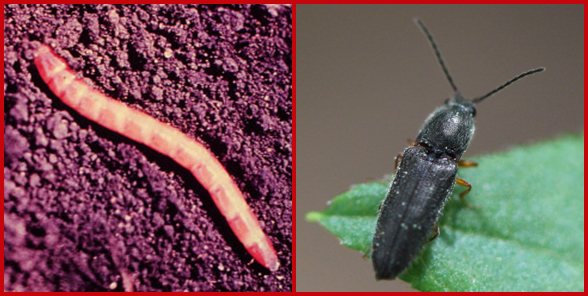https://www.epicgardening.com/wireworm/
But what do click beetles eat? The adult beetles tend to eat nectar and pollen from flowers.
Hence the Click Beetles in the trap.
Click beetles prefer to lay their eggs in grassy areas,
https://www.planetnatural.com/pest-problem-solver/garden-pests/wireworm-control/
Potatoes make great wireworm traps. Cut a potato in half and run a stick through the middle. Bury the spud about one inch deep so that the stick stands vertically as a handle. Pull the traps out after a day or two and discard wireworms.
hmm.
Perhaps the most effective control is the use of predatory nematode, Heterorhabditis megidis.
Read more at Gardening Know How: Wireworm Control: How To Get Rid Of Wireworm Pests https://www.gardeningknowhow.com/plant-problems/pests/insects/controlling-wireworm-pests.htm
Read more at Gardening Know How: Wireworm Control: How To Get Rid Of Wireworm Pests https://www.gardeningknowhow.com/plant-problems/pests/insects/controlling-wireworm-pests.htm
https://www.gardeningknowhow.com/plant-problems/pests/insects/controlling-wireworm-pests.htm
https://www.cotswoldseeds.com/articles/628/considering-a-grass-reseed-beware-of-wireworms
Elateridae or click beetles are family of beetles.
https://pnwhandbooks.org/insect/legume-grass-field-seed/grass-seed/grass-seed-wireworm-click-beetle
OK the trap did not check any Click Beetles - although there might be one "hanging out" on the side of the trap. haha.
Adult Click Beetles mate in April and then in May-June they lay eggs (around 60-300 at any one time) in grassy swards or just below the ground. The eggs hatch about a month after laying (July-August). The full life cycle of the larvae can take up to 5 years, during which they are feeding and slowly maturing below the ground, meaning that a field can contain every stage of adult and larvae at any one time. The larvae pupate into adults in July-August, leading to the next cycle of egg laying the following spring.
4 year cycle that overlaps?
Wireworms, the juvenile larvae of the click beetle (Elateridae) are a particular risk to crops which follow grass within a four year period. It’s believed that the wireworms feed on ploughed down grass for approximately six months, before moving to the surface to damage the next two crops, especially during the early spring when soils are cold. The click beetle itself overwinters in hedgerows and grassy areas and has a 12 month lifespan but the adults are not thought to damage mainstream crops.
Thymol had the greatest contact toxicity
will Nematodes work?
These results indicate that in entomopathogenic nematodes,https://res.mdpi.com/d_attachment/agriculture/agriculture-11-00436/article_deploy/agriculture-11-00436-v2.pdf
the control achieved against wireworms is, besides the environmental factors discussed
below, dependent on the concentration of infectious juveniles and on the combination of
nematode strain and wireworm species.
Esters of geraniol are the main components of Agriotes natural sex pheromones [63], given
that female pheromone glands contain up to 24 substances [62]. Varying the mixture
formulation allows each species to be caught selectively or, alternatively, several of them to
be attracted to the same trap [64]. Recently, several kinds of pheromone traps have been
developed and used as research tools to monitor populations in both Europe and North
America [24,26,65]. The female sex pheromones of most major European click-beetle pest
species (A. brevis, A. lineatus, A. obscurus, A.proximus, A. rufipalpis, A. sordidus, A. sputator,
A. ustulatus, A. litigiosus) have been characterized [64]. YATLORF (Yf) sex pheromone traps
(Figure 3A) were designed for a range of Agriotes species, including all of the most harmful
ones in Europe and part of the Agriotes pests in North America.
So WHY is a supposed insectide using a phermone attractant?
which suits us just fine, since our muscles can efficiently generate sustained outputs of power. But click beetles don’t need sustained power to perform their incredible jumps. Instead, click beetles lock, load, and fire themselves using spring-latch systems similar to the inner workings of a mechanical camera.
In normal situations, the click beetle skitters around like any other beetle on six tiny legs. But occasionally these beetles find themselves on their back with the ground hopelessly out of reach of their little legs. In such a situation, a click beetle may appear to squirm and flail at first, but soon enough it will begin to arch its back, pause, and then explode upwards with a loud CLICK. This jump can launch a beetle with accelerations up to 300-times that of gravity, or 100-times larger than the acceleration felt by astronauts during a rocket launch. The jump gives them an opportunity to roll and somersault in the air, hopefully landing back on their feet.
https://massivesci.com/articles/click-beetle-mechanics-jump-fast/
OK I'm going to just make baitballs out of oatmeal, honey and water.
Then dig and bury under the grass - and check back in a week.
During the early stages lasting one to two years, wireworms are very small and white. Mature larvae lasting two to six years are hard-shelled with dark transverse bands along the length of their body. The body color is a shiny yellow to rust.
So these wireworms are at least two years old.
"The ones on the west coast in the US and Canada are nasty to dahlia tubers, but the species of wireworm dominate on the East coast prefer eating grass crops over tuberous crops. I remember doing the potato test on the soil's surface to check for their presence, and only accumulating quite a pill bug collection."
OK I'm gonna use this stuff - Nano-thymol...
I'll pour this over the grass... and under the new sod....
During the late summer when the larvae get large enough and prepare to pupate and become adults, they again return to the top 4 – 6 inches of soil. Here they go through a short pupation and turn into adult click beetles in August and September. After mating, the females deposit from 200 to 400 eggs in the top 6 inches of the soil. The eggs will hatch into larvae within three to seven weeks.
https://seedworld.com/wily-wireworm-unpredictable-pest/



No comments:
Post a Comment